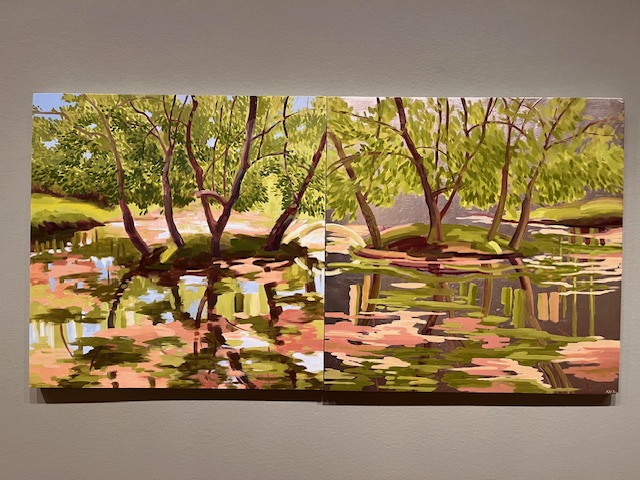Your cart is currently empty!
Addison Gallery of American Art Explores Indigenous Land, Everyday Life, Americans In Paris

The Addison Gallery of American Art stands tall amongst the lush Phillips Academy Andover campus. The museum invites students, faculty, and the general public to admire its collection of over 28,000 works that span from the 18th century to today.
The doors lead visitors to a rotunda replete with an ornate tiled floor and Paul Manship’s Venus Anadyomene, a sculpture of Venus in a tight kneel, her hair flowing over her face. Much of the galleries on the first floor display the ongoing exhibition Kay Walkingstick / Hudson River School. Kay Walkingstick is a contemporary Cherokee artist whose work challenges the nineteenth-century Hudson River School painters. Walkingstick’s paintings make indigenous people the stewards of the land. Her work reminds viewers that all land is indigenous land. The nineteenth-century Hudson River School painters forged the American landscape tradition. The exhibition strategically places these works together to juxtapose differing ideologies and reveal a shared reverence for nature and a mutual belief for art to give agency to humankind’s relationship to the land. Much of Kay Walkingstick’s work depicts a dichotomy between still and moving landscapes. On one side, she implements beeswax and honey amidst an abstract shape. On the other side, she highlights reflection, a flowing body of water. In one corner of the exhibit stands Walkingstick and a Hudson River School artist’s take on the same landscape. On the right, the Hudson River School artist creates an overcast scene with a muddy river and an aged rock formation. On the right, Walkingstick portrays a bluebird day with a clear river and a sunlit rock formation. The juxtaposition is stunning.
The second floor of the museum focuses on the ongoing exhibition Figure/Ground. The exhibition grapples with how people interact with their surroundings. Some seem uneasy while others seem content against the urban and pastoral settings. It illustrates how human experience is shaped by the spaces we inhabit. The varied scenes suggest narratives and prompt reflection on how we relate to our own environments. The artwork plays around with colors, styles, and techniques, but they all display ordinary life. In one painting, three women are drying their hair on an urban rooftop. In a photograph, a woman and her child are trudging through the rain on a city sidewalk. In another painting, men hike up a snow-covered hill carrying bayonets, their hunting dogs sniffing the ground. The piece is bright in the foreground, the snow seeming icy and crunchy. The background is ominous, a deep gray.
The third floor of the museum showcases the ongoing exhibition Americans In Paris. The exhibit examines Americans creating art in postwar France from 1946-1962. These creatives lived in France for a year or more during this period and experimented with a range of formal strategies and various approaches to both abstraction and figuration. Some of the expatriates were veterans who utilized the G.I. Bill to finance their trip abroad. Others were women who self-financed their experience. The art on display includes sculptures, photographs, textiles, and works on paper. A complementary section, called the “Salon,” explores work from French and foreign artists that Americans would have viewed in galleries and salons during the time. Much of the art in the exhibit is vibrant and multilayered. In one painting, the artist stacks shapes and colors, creating a final piece that is complex and dynamic. In another painting, hues of blue and red and black on the edges of the canvas depict a battle of the unknown. The white space in the middle represents a stasis.
The Addison Gallery of American Art is open Tuesday-Sunday from 10am-5pm and on Sunday from 1pm-5pm. It is free of charge and open to the public. For more information, visit https://addison.andover.edu/.